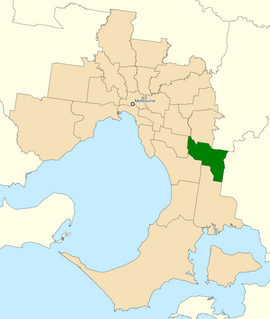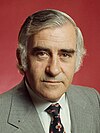Division of Bruce
| Bruce Australian House of Representatives Division | |
|---|---|
 Division of Bruce in Victoria, as of the 2022 federal election | |
| Created | 1955 |
| MP | Julian Hill |
| Party | Labor |
| Namesake | Stanley Bruce |
| Electors | 112,896 (2022) |
| Area | 115 km2 (44.4 sq mi) |
| Demographic | Outer metropolitan |
The Division of Bruce is an Australian Electoral Division in the state of Victoria. The division is located in the south-eastern suburbs of Melbourne. It covers an area of approximately 115 square kilometres (44 sq mi) [1] including the suburbs of Dandenong North, Doveton, Endeavour Hills, Eumemmerring, Hallam, Lysterfield South, Narre Warren, and Narre Warren North; and parts of Berwick, Dandenong, Harkaway, Mulgrave, Narre Warren South, Noble Park, and Noble Park North.[2]
Geography[edit]
Since 1984, federal electoral division boundaries in Australia have been determined at redistributions by a redistribution committee appointed by the Australian Electoral Commission. Redistributions occur for the boundaries of divisions in a particular state, and they occur every seven years, or sooner if a state's representation entitlement changes or when divisions of a state are malapportioned.[3]
History[edit]

The division was created in 1955, and is named for Stanley Bruce, who was Prime Minister of Australia from 1923 to 1929. Unusually, the division was named after a living person, as Bruce did not die until 1967.
Until 1996, the division was based on Glen Waverley and Mount Waverley, and was a fairly safe seat for the Liberal Party, but since then its boundaries have been extended southwards, making it a marginal Labor Party seat.[4]
Its most prominent member was Sir Billy Snedden, Liberal Party leader from 1972 to 1975 and Speaker of the Australian House of Representatives from 1976 to 1983. At the 2011 Census, the division had the nation's highest proportion of residents born overseas (50.8%), and the third highest proportion born in a non-English speaking country (45.4%). It also has the sixth highest proportion speaking a language other than English at home (51.6%), the highest for any Victorian electorate.[4]
The current Member for Bruce, since the 2016 federal election, is Julian Hill, who is a member of the Australian Labor Party.
Demographics[edit]
Bruce is a diverse and socially conservative electorate[5] and is historically working-class. Bruce has three times the proportion of families with Chinese backgrounds as the state average.[5] While a stronghold for the center-left Labor Party, religious migrant communities in the electorate rallied strongly against the Australian Marriage Law Postal Survey in 2017, since the survey process was not trusted by both Islamic and Chinese Christian migrant communities, who believe it had been hijacked by out-of-touch inner-city leaders.[5]
Members[edit]
| Image | Member | Party | Term | Notes | |
|---|---|---|---|---|---|

|
(Sir) Billy Snedden (1926–1987) |
Liberal | 10 December 1955 – 21 April 1983 |
Served as minister under Menzies, Holt, McEwen, Gorton and McMahon. Served as Opposition Leader from 1972 to 1975. Served as Speaker during the Fraser Government. Resigned to retire from politics | |

|
Ken Aldred (1945–2016) |
Liberal | 28 May 1983 – 24 March 1990 |
Previously held the Division of Henty. Lost preselection. Transferred to the Division of Deakin | |

|
Julian Beale (1934–2021) |
Liberal | 24 March 1990 – 2 March 1996 |
Previously held the Division of Deakin. Lost seat | |

|
Alan Griffin (1960–) |
Labor | 2 March 1996 – 9 May 2016 |
Previously held the Division of Corinella. Served as minister under Rudd and Gillard. Retired | |

|
Julian Hill (1973–) |
Labor | 2 July 2016 – present |
Incumbent |
Election results[edit]
| Party | Candidate | Votes | % | ±% | |
|---|---|---|---|---|---|
| Labor | Julian Hill | 39,516 | 41.47 | −6.57 | |
| Liberal | James Moody | 28,837 | 30.26 | −5.43 | |
| Greens | Matthew Kirwan | 9,273 | 9.73 | +2.10 | |
| United Australia | Matt Babet | 8,299 | 8.71 | +4.61 | |
| Liberal Democrats | Christine Skrobo | 4,821 | 5.06 | +5.06 | |
| One Nation | Hayley Deans | 4,544 | 4.77 | +3.75 | |
| Total formal votes | 95,290 | 95.66 | +0.76 | ||
| Informal votes | 4,321 | 4.34 | −0.76 | ||
| Turnout | 99,611 | 88.34 | −3.67 | ||
| Two-party-preferred result | |||||
| Labor | Julian Hill | 53,920 | 56.59 | −0.69 | |
| Liberal | James Moody | 41,370 | 43.41 | +0.69 | |
| Labor hold | Swing | −0.69 | |||
References[edit]
- ^ Australian Electoral Commission https://www.aec.gov.au/profiles/vic/bruce.htm
- ^ "Profile of the electoral division of Bruce (Vic)". Current federal electoral divisions. Australian Electoral Commission. 30 June 2022. Retrieved 16 September 2022.
- ^ Muller, Damon (14 November 2017). "The process of federal redistributions: a quick guide". Parliament of Australia. Retrieved 19 April 2022.
- ^ a b Green, Antony (11 October 2013). "Federal election 2013: Bruce results". Australia Votes. Australia: ABC. Retrieved 23 November 2013.
- ^ a b c Bagshaw, Eryk (16 November 2017). "Same-sex marriage result: Why multicultural communities registered huge 'no' votes". The Sydney Morning Herald. Retrieved 7 June 2022.
- ^ Bruce, VIC, 2022 Tally Room, Australian Electoral Commission.
